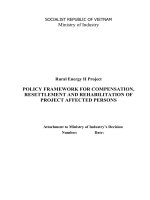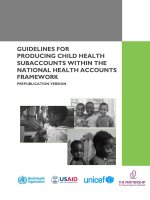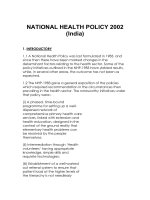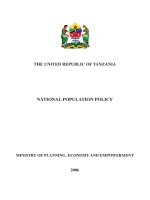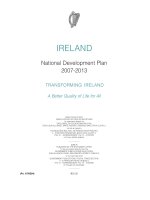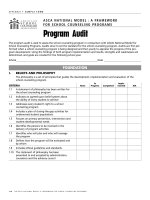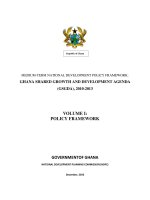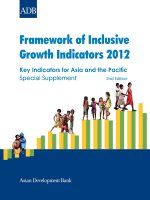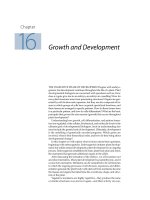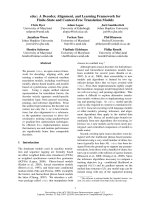MEDIUM-TERM NATIONAL DEVELOPMENT POLICY FRAMEWORK: GHANA SHARED GROWTH AND DEVELOPMENT AGENDA (GSGDA), 2010-2013 potx
Bạn đang xem bản rút gọn của tài liệu. Xem và tải ngay bản đầy đủ của tài liệu tại đây (1.67 MB, 232 trang )
MEDIUM-TERM NATIONAL DEVELOPMENT POLICY FRAMEWORK:
GHANA SHARED GROWTH AND DEVELOPMENT AGENDA
(GSGDA), 2010-2013
VOLUME I:
POLICY FRAMEWORK
GOVERNMENTOF GHANA
NATIONAL DEVELOPMENT PLANNING COMMISSION (NDPC)
December, 2010
Republic of Ghana
i
i
TABLE OF CONTENTS
TABLE OF CONTENTS I
LIST OF TABLES AND FIGURES IV
LIST OF ACRONYMS V
EXECUTIVE SUMMARY XII
CHAPTER ONE: INTRODUCTION 1
1.1 PURPOSE 1
1.2 BACKGROUND 2
1.3 POLICY CONTEXT AND STRATEGIC DIRECTION 4
CHAPTER TWO: ENSURING AND SUSTAINING MACROECONOMIC STABILITY 6
2.1 INTRODUCTION 6
2.2 REVIEW OF ECONOMIC PERFORMANCE 6
2.3 ACCELERATING GROWTH IN THE MEDIUM-TERM 10
2.4 KEY MACROECONOMIC POLICIES AND STRATEGIES 17
CHAPTER THREE: ENHANCING COMPETITIVENESS OF GHANA’S PRIVATE SECTOR . 22
3.1 INTRODUCTION 22
3.2 PRIVATE SECTOR DEVELOPMENT 22
3.3 PROMOTE GOOD CORPORATE GOVERNANCE 28
3.4 DEVELOP MICRO, SMALL, AND MEDIUM ENTERPRISES (MSMES) 28
3.5 ACCELERATED INDUSTRIAL DEVELOPMENT 30
3.6 DEVELOPING THE TOURISM INDUSTRY FOR JOBS AND REVENUE GENERATION 32
3.7 PROMOTE THE CREATIVE INDUSTRY FOR ECONOMIC DEVELOPMENT 33
CHAPTER FOUR: ACCELERATED AGRICULTURAL MODERNISATION AND
SUSTAINABLE NATURAL RESOURCE MANAGEMENT 34
4.1 ACCELERATED AGRICULTURAL MODERNISATION 34
4.2 SUSTAINABLE NATURAL RESOURCE MANAGEMENT 41
CHAPTER FIVE: OIL AND GAS DEVELOPMENT 52
5.1 INTRODUCTION 52
5.2 OIL AND GAS INDUSTRY DEVELOPMENT 52
5.3 EMPLOYMENT CREATION 54
5.4 PROTECTING THE ENVIRONMENT 54
5.5 TRANSPARENCY IN REVENUE MANAGEMENT 55
ii
CHAPTER SIX: INFRASTRUCTURE AND HUMAN SETTLEMENTS 56
6.1 INTRODUCTION 56
6.2 TRANSPORTATION: ROAD, RAILWAY, MARITIME AND RIVERINE TRANSPORT AND
AVIATION 56
6.3 SCIENCE, TECHNOLOGY AND INNOVATION TO SUPPORT PRODUCTIVITY AND
DEVELOPMENT 58
6.4 INFORMATION AND COMMUNICATION TECHNOLOGY DEVELOPMENT 58
6.5 RECREATIONAL INFRASTRUCTURE 59
6.6 ENERGY SUPPLY TO SUPPORT INDUSTRIES AND HOUSEHOLDS 60
6.7 HUMAN SETTLEMENTS DEVELOPMENT 66
CHAPTER SEVEN: HUMAN DEVELOPMENT, PRODUCTIVITY AND EMPLOYMENT 74
7.1 INTRODUCTION 74
7.2 EDUCATION 74
7.3 HEALTH 79
7.4 HIV AND AIDS/STI/TB 83
7.5 NUTRITION AND FOOD SECURITY 83
7.6 SPORTS DEVELOPMENT 84
7.7 PRODUCTIVITY AND EMPLOYMENT 85
7.8 POPULATION MANAGEMENT 88
7.9 CHILD SURVIVAL, DEVELOPMENT AND PROTECTION 90
7.10 YOUTH DEVELOPMENT 91
7.11 AGEING 91
7.12 DISABILITY 92
7.13 REDUCTION OF POVERTY AND INCOME INEQUALITIES 92
7.14 SPECIAL DEVELOPMENT ZONES 95
CHAPTER EIGHT: TRANSPARENT AND ACCOUNTABLE GOVERNANCE 97
8.1 INTRODUCTION 97
8.2 CHALLENGES TO GOOD GOVERNANCE 97
8.3 DEEPENING THE PRACTICE OF DEMOCRACY AND INSTITUTIONAL REFORM 97
8.4 STRENGTHENING LOCAL GOVERNANCE AND DECENTRALIZATION 99
8.5 PUBLIC POLICY MANAGEMENT 101
8.6 PUBLIC SECTOR REFORMS 103
8.7 DEVELOPMENT COMMUNICATION 106
8.8 WOMEN AND GOVERNANCE 107
8.9 FIGHTING CORRUPTION AND ECONOMIC CRIMES 107
8.10 ENHANCING RULE OF LAW & JUSTICE 108
8.11 ENSURING PUBLIC SAFETY AND SECURITY 108
8.12 IMPROVING ACCESS TO RIGHTS AND ENTITLEMENTS 109
8.13 PROMOTION OF NATIONAL CULTURE FOR DEVELOPMENT 111
8.14 STRENGTHENING DOMESTIC AND INTERNATIONAL RELATIONS (PARTNERSHIP)
FOR DEVELOPMENT 111
8.15 PROMOTING EVIDENCE-BASED DECISION-MAKING 112
iii
CHAPTER NINE: ENABLING ENVIRONMENT FOR EFFECTIVE PLAN PREPARATION
AND IMPLEMENTATION 113
9.1 INTRODUCTION 113
9.2 RELATIONSHIPS, ROLES AND RESPONSIBILITIES OF KEY PLANNING AGENCIES 114
9.3 COMMUNICATION FOR PLANNING, IMPLEMENTATION, MONITORING AND
EVALUATION 117
9.4 STAKEHOLDER CONSULTATION AND PARTICIPATION 120
9.6 ESTABLISHING CONDITIONS FOR PLAN STABILITY AND NATIONAL OWNERSHIP 123
9.7 DEVELOPING CAPACITIES OF KEY PLANNING AGENCIES 123
CHAPTER TEN: MONITORING AND EVALUATION 126
10.1 INTRODUCTION 126
10.2 REVIEW OF THE M&E UNDER THE GPRS I & II 126
10.3 M&E CHALLENGES UNDER GPRS I & II 127
10.4 MONITORING AND EVALUATION UNDER GSDSA 127
10.5 M&E INSTITUTIONAL ARRANGEMENTS UNDER THE GSGDA 129
APPENDIX 1: SECTORAL GROWTH AND CONTRIBUTION TO GDP, 2010 – 2013 130
Appendix table 2.1: GDP Growth Projections, 2010 – 2013 130
Appendix table 2.2: Sectoral Distribution of GDP, 2010 – 2013 131
APPENDIX 2: MATRICES - MEDIUM-TERM DEVELOPMENT POLICY FRAMEWORK,
2010 – 2013 132
Appendix 2.1: Ensuring and sustaining macroeconomic stability 132
Appendix 2.2: Enhancing competitiveness in ghana’s private sector 135
Appendix 2.3: Accelerated agricultural modernisation and sustainable natural resource
management 140
Appendix 2.4: Oil and gas development 160
Appendix 2.5: Infrastructure and human settlements development 163
Appendix 2.6: Human development, productivity and employment 184
Appendix 2.7: Transparent and accountable governance 193
iv
LIST OF TABLES AND FIGURES
LIST OF TABLES
Table 2.1: Sector and Sub-Sector Real Growth Rates, 1998 – 2009 7
Table 2.2: Medium-Term Projected Real GDP Growth, 2010-2013 10
Table 2.3: GDP Growth Projections, 2010 – 2013 11
Table 9.1: Roles and Responsibilities of Key Planning Institutions 114
LIST OF FIGURES
Figure 2.1: Structure of Ghanaian Economy 8
Figure 2.1: Annual Consumer Inflation (%) 17
Figure 2.2: Trends in Interest Rates (%) 18
Figure 2.3: Exchange Rate Movements (%) 18
Figure 10.1 Institutional Arrangements under GSGDA 129
v
LIST OF ACRONYMS
AESL Architectural and Engineering Services Limited
A-G Attorney-General
AGI Association of Ghanaian Industries
AGOA Africa Growth and Opportunity Act
AIDS Acquired Immunodeficiency Syndrome
AMSEC Agriculture Mechanization and Service Centres
APR Annual Progress Report
ART Anti-Retroviral Therapy
ASSI Association of Small-Scale Industries
ATAG Aid to Artisans of Ghana
BDR Births and Deaths Registry
BOG Bank of Ghana
BOST Bulk Oil Storage and Transport Limited
BPA Bui Power Authority
BRIC Brazil, Russia, India and China
BRRI Building and Road Research Institute
BRT Bus Rapid Transit
BTS Blood Transfusion Service
CAADP Comprehensive Africa Agriculture Development Programme
CAGD Controller and Accountant-General’s Department
CBO Community-Based Organisation
CBT Competency-Based Training
CDD Centre for Democratic Development
CEDECOM Central Region Development Commission
CEPS Customs Excise and Preventive Service
CERSGIS Centre for Remote Sensing and Geographic Information System
CET Common External Tariffs
CHAG Christian Health Association of Ghana
CHASS Conference of Head of Assisted Secondary Schools
CHPS Community-Based Health Planning Services
CHRAJ Commission on Human Rights and Administrative Justice
CICs Community Information Centres
CO
2
Carbon Dioxide
CPI Consumer Price Index
CRC Constitutional Review Commission
CSIR Centre for Scientific and Industrial Research
CSOs Civil Society Organisations
C-TPAT Customs-Trade Partnership Against Terrorism
CWIQ Core Welfare Indicators Questionnaire
CWSA Community Water and Sanitation Agency
DA District Assembly
DAAS District Agricultural Advisory Services
DACF District Assemblies Common Fund
DDF District Development Fund
vi
DFR Department of Feeder Roads
DHIMS District Health Information Management System
DMTDP District Medium-Term Development Plans
DOT Directly Observed Therapy
DPCU District Planning Coordinating Unit
DPD Directorate of Public Defenders
DPs Development Partners
DRH Doctors for the Right to Health
DSDA Danish Support for District Assemblies
DSW Department of Social Welfare
DUR Department of Urban Roads
DVLA Driver Vehicle and Licensing Authority
DWSP District Water and Sanitation Plan
EC Energy Commission
ECG Electricity Company of Ghana
ECOWAS Economic Community of West African States
ECRAG Entertainment Critics and Reviewers Association of Ghana
EDIF Export Development and Investment Fund
EEZ Exclusive Economic Zone
EFA Education For All
EITI Extractive Industries Transparency Initiative
EOCO Economic and Organised Crimes Office
EPA Environmental Protection Agency
ESIA Environmental and Social Impact Assessment
ETLS ECOWAS Trade Liberalisation Scheme
EXIM Export and Import
FAO Food and Agriculture Organisation
FASDEP Food and Agriculture Sector Development Programme
FBO Farmer Based Organisation
FBOs Faith Based Organizations
FDI Foreign Direct Investment
FINSSP Financial Sector Strategic Plans
FLEGT Forest Law Enforcement, Governance and Trade
FP Family Planning
FWSC Fair Wages and Salaries Commission
GACL Ghana Airports Company Limited
GAEC Ghana Atomic Energy Commission
GAP Good Agricultural Practices
GAPI Ghana Association of Phonographic Industries
GCAA Ghana Civil Aviation Authority
GACC Ghana Anti-Corruption Coalition
GDP Gross Domestic Product
GEA Ghana Employers Association
GEPC Ghana Export Promotion Council
GES Ghana Education Service
GETFund Ghana Education Trust Fund
vii
GFD Ghana Federation of the Disabled
GHA Ghana Highway Authority
GHATOF Ghana Tourism Federation
GHS Ghana Health Service
GIFMIS Ghana Integrated Financial Management Information System
GIMPA Ghana Institute for Management and Public Administration
GIPC Ghana Investment Promotion Centre
GIS Geographic Information System
GLSS Ghana Living Standard Survey
GMA Ghana Medical Association
GNAT Ghana National Association of Teachers
GNFS Ghana National Fire Service
GPHA Ghana Ports and Harbours Authority
GPRS Ghana Poverty Reduction Strategy
GPRTU Ghana Private Road Transport Union
GPS Global Positioning System
GRA Ghana Revenue Authority
GRATIS Ghana Regional Appropriate Technology Industrial Service
GRCL Ghana Railway Company Limited
GRIDCO Ghana Grid Company
GRMA Ghana Registered Midwives Association
GSE Ghana Stock Exchange
GSGDA Ghana Shared Growth and Development Agenda
GSS Ghana Statistical Service
GTB Ghana Tourist Board
GUTP Ghana Urban Transport Project
GWCL Ghana Water Company Limited
H1N1 Hemagglutinin1 Neuraminidase1
HACCP Hazard Control and Critical Analysis
HELPAGE Help Age Ghana
HIPC Highly Indebted Poor Countries
HIRD High Rapid Impact Delivery
HIV Human Immunodeficiency Virus
HOTCATT Hotel Catering and Tourism Training Centre
HRD Human Resources Development
HSC/A Human Settlements Commission/Authority
ICAO International Civil Aviation Organization
ICCES Integrated Community Centres for Employable Skills
ICD Independent Complaints Directorate
ICE Information, Communication and Education
ICT Information Communication Technology
IDEG Institute for Democratic Governance
IEA Institute of Economic Affairs
IGF Internally Generated Fund
IGFF Inter-Governmental Fiscal Framework
ILGS Institute of Local Government Studies
viii
IMD Institute for Music and Development
IMF International Monetary Fund
IMO International Maritime Organization
IMT Intermediate Means of Transport
INSET In-Service Education and Training
IPPs Independent Power Producers
IRS Indoor Residential Spraying
IRS Internal Revenue Service
ISD Information Services Department
ITN Insecticides Treated Nets
ITTU Intermediate Technology Transfer Unit
IWRM Integrated Water Resources Management
JFFLS Junior Farm Field and Life Schools
KIA Kotoka International Airport
LAP Land Administration Project
LCG Low Carbon Growth
LEAP Livelihood Empowerment Against Poverty
LI Legislative Instrument
LPG Liquified Petroleum Gas
LRC Legal Resource Centre
LUPMP Land Use Planning and Management Project
LUS Lesser Used Species
MA Maritime Academy
MAB Ministerial Advisory Boards
MCC Millennium Challenge Corporation
MDAs Ministries, Departments and Agencies
MDBS Multi-Donor Budgetary Support
MDGs Millennium Development Goals
MDPI Multidisciplinary Digital Publishing Institute
MEST Ministry of Environment, Science and Technology
MESW Ministry of Employment and Social Welfare
MFA Ministry of Foreign Affairs
MiDA Millennium Development Authority
MLGRD Ministry of Local Government and Rural Development
MLNR Ministry of Lands and Natural Resources
MMDAs Metropolitan, Municipal and District Assemblies
MMTL Metro Mass Transit Limited
MOC Ministry of Communications
MOD Ministry of Defence
MoEn Ministry of Energy
MOFA Ministry of Food and Agriculture
MOFEP Ministry of Finance and Economic Planning
MOH Ministry of Health
MOI Ministry of Information
MINT Ministry of Interior
MOJ Ministry of Justice
ix
MOT Ministry of Tourism
MoTr Ministry of Transport
MOTI Ministry of Trade and Industry
MOWAC Ministry of Women and Children’s Affairs
MoYS Ministry of Youth and Sports
MRH Ministry of Roads and Highways
MSMEs Micro, Small and Medium Enterprises
MTTU Motor and Traffic Transport Union
MUSIGA Musicians Union of Ghana
MWRWH Ministry of Water Resources, Works and Housing
NABPTEX National Board for Professional & Technician Examinations
NACP National Aids Control Programme
NADMO National Disaster and Management Organisation
NAGRAT National Association of Graduate Teachers
NAMAS National Appropriate Mitigation Actions
NBSSI National Board for Small Scale Industries
NCA National Communication Authority
NCCE National Council for Civic Education
NCPD National Council on Persons with Disabilities
NCWD National Council on Women and Development
NDAP National Decentralization Action Plan
NDPC National Development Planning Commission
NED National Economic Dialogue
NEPAD New Partnership for African Development
NFE Non-Formal Education
NGO Non-Governmental Organisation
NHIA National Health Insurance Authority
NHIS National Health Insurance Scheme
NIA National Identification Authority
NIC National Insurance Commission
NLC National Labour Commission
NMC National Media Commission
NPA National Petroleum Authority
NPC National Petroleum Council
NRSC National Road Safety Commission
NVTI National Vocational and Technical Institute
NYC National Youth Council
NYEP National Youth Employment Programme
OHCS Office of the Head of Civil Service
OoP Office of the President
PAC Project Advisory Committee
PEF Private Enterprise Foundation
PHMHB Private Hospitals and Maternity Homes Board
PIP Public Investment Programme
PLHIV People Living with HIV/AIDs
PMU Project Management Unit
x
PPA Public Procurement Authority
PPAG Planned Parenthood Association of Ghana
PPMED Policy Planning, Monitoring and Evaluation Division
PPP Public-Private Partnership
PPR Pest De Petit Ruminant
PROMAG Professional Musicians Association of Ghana
PSC Public Services Commission
PSDS Private Sector Development Strategy
PSIAs Poverty and Social Impact Analysis
PSRS Public Sector Reform Secretariat
PURC Public Utilities and Regulatory Commission
PWDs Persons with Disabilities
R&D Research and Development
RCC Regional Coordinating Council
REDD+ Reducing Emission from Deforestation and Forest Degradation plus
RELCs Research Extension Farmer Linkages
RPCU Regional Planning Coordination Unit
RTTU Regional Technology Transfer Unit
RUEAP Rural and Urban Entrepreneurship and Artisan Project
SADA Savannah Accelerated Development Authority
SBA Small Businesses Association
SDZ Special Development Zone
SEA Strategic Environment Assessment
SFO Serious Fraud Office
SIP Strategic Investment Plans
SNA System of National Accounts
SOE State Owned Enterprise
SSNIT Social Security and National Insurance Trust
STD Sexually Transmitted Diseases
STI Science, Technology and Innovation
TCPD Town and Country Planning Department
TLM Teaching and Learning Material
TOR Tema Oil Refinery
TUC Trade Union Congress
TVET Technical and Vocational Education and Training
TVI Technical and Vocational Institution
UG SPH University of Ghana School of Public Health
UNFPA United Nations Population Fund Agency
UTTDBE Untrained Teachers Diploma in Basic Education
VAT Value-Added Tax
VLTC Volta Lake Transport Company
VOC Vehicle Operating Costs
VPA Voluntary Partnership Agreement
VRA Volta River Authority
WAMZ West Africa Monetary Zone
WCO World Customs Organisation
xi
WFCL Worst Forms of Child Labour
WIRA Women in Reproductive Ages
WRC Water Resources Commission
WTO World Trade Organisation
xii
EXECUTIVE SUMMARY
1.0 Introduction and Strategic Direction
In preparing this Medium-Term Development Policy Framework, Ghana Shared Growth and
Development Agenda (GSGDA, 2010-2013), Government responds to the constitutional
injunction, which requires that policies leading to the establishment of a just and free society are
pursued by the state. Government’s Better Ghana Agenda also emphasises the following:
expanding access to potable water and sanitation, health, housing and education; reducing
geographical disparities in the distribution of national resources; ensuring environmental
sustainability in the use of natural resources through science, technology and innovation;
pursuing an employment-led economic growth strategy that will appropriately link agriculture to
industry, particularly manufacturing; and improving transparency and accountability in the use of
public funds and other national resources.
Since 1957, several policies and programmes to accelerate the growth of the economy and raise
the living standards of the people have been pursued with varying degrees of success. These
include Ghana Vision 2020: The First Step (1996-2000); the First Medium-Term Plan (1997-
2000); Ghana Poverty Reduction Strategy (2003-2005); and the Growth and Poverty Reduction
Strategy (2006-2009). Under these strategic programmes, substantial progress was made towards
the realisation of macro-economic stability and the achievement of poverty reduction goals.
Structural challenges characterised by large fiscal and balance of payment deficits have,
however, remained.
In many respects, this medium-term development policy framework seeks to address the
challenges and set-backs of the immediate past. It is also programmed to accelerate employment
creation and income generation for poverty reduction and shared growth.
Within the contexts of the constitutional requirement and the Better Ghana Agenda, the GSGDA
is anchored on the following themes:
• Ensuring and sustaining macroeconomic stability;
• Enhanced competitiveness of Ghana’s private sector;
• Accelerated agricultural modernisation and natural resource management;
• Oil and gas development;
• Infrastructure, energy and human settlements development;
• Human development, employment and productivity; and
• Transparent and Accountable Governance.
2.0 Ensuring and Sustaining Macroeconomic Stability
The overarching goal of the medium-term economic development policy is to achieve and
sustain economic stability while placing the economy on a path of higher growth in order to
attain a per capita income of at least US$3,000 by 2020 while also achieving the Millennium
Development Goals (MDGs).
xiii
Towards this end, the focus of the macroeconomic framework emphasises interventions in the
following policy areas:
• Monetary and financial sectors;
• Fiscal policy management;
• Economic policy management;
• International trade management ; and
• Employment, unemployment and wage policies.
2.1 The Medium-Term Macroeconomic Growth Targets and Underlying Assumptions
On the base of the old GDP series, the medium-term, per capita income is projected to reach at
least US$1,035 by 2013 with a projected non-oil average real GDP growth rate of 7% per
annum, and an oil average real GDP growth rate of at least 9%. This is to enable Ghana to
achieve and sustain per capita income levels consistent with the long-term objective of a per
capita income of at least US$3,000 by the year 2020 without compromising macroeconomic
stability. These growth targets assume that the trend of buoyant prices for Ghana’s two main
exports, cocoa and gold, will continue and Ghana would take advantage of the favourable world
market prices and increase the volumes of exports of these commodities. It is also assumed
among others that:
• The population growth rate will not exceed 2.2% per annum;
• Inflation rate is contained within single digit; and
• Stable foreign exchange rates.
It is further assumed that in spite of the prospects of increased revenue from oil, Ghana will
continue accessing development assistance on account of the existing large deficit in economic
and social infrastructure, the need to intensify efforts to achieve the MDGs as well reduce spatial
disparities in development. To ensure aid effectiveness and coordination, the Ghana Aid Policy
and Strategy provides for aligning external aid to Ghana’s national development priorities; and
serves as a guide to Government, Development Partners, Civil Society Organizations and other
stakeholders in the management and coordination of external aid in Ghana.
2.2 Structure of the economy
Currently, under the old series with 1993 constant prices, agriculture constitutes the dominant
sector of the economy, followed by services and industry respectively. Over the medium-term,
the structure of the economy is projected to change significantly in favour of services and
industry sectors. The development of infrastructure , salt-based industry, and petro-chemical
industry to support oil and gas production; the development of an integrated aluminium industry
on the back of adequate and affordable energy supply, etc all hold great prospects of long-term
industrial transformation of the economy.
3.0 Enhancing Competitiveness of Ghana’s Private Sector
Ghana’s private sector is dominated by a very large number of Micro, small and medium
enterprises (MSMEs) and a few large multinational companies and in spite of several attempts by
xiv
various Governments to enhance its competitiveness, the sector remains uncompetitive both
locally and internationally. This is largely attributed to a number of structural constraints at the
policy and institutional levels which hamper its developmental role. The private sector is
expected to partner Government and other stakeholders in the transformation of the economy
through modernized agriculture, and the exploitation and processing of Ghana’s natural resource
endowments.
The key strategies for enhancing the competitiveness of the private sector are: private sector
development; good corporate governance; development of viable and efficient micro, small and
medium enterprises (MSMEs); accelerated industrial development; development of the tourism
industry; and the promotion of the Creative Industry.
4.0 Accelerated Agricultural Modernisation and Sustainable Natural Resource Management
4.1 Accelerated Agricultural Modernisation
Ghana’s agriculture is dominated by subsistence small holder production units with weak
linkages to industry and the services sector. The sector is also characterized by low level of
technology and productivity, low income and un-competitiveness in production, processing and
distribution.
The main focus of agriculture development, over the medium-term, will be to accelerate the
modernisation of agriculture through the implementation of the Food and Agriculture Sector
Development Policy (FASDEP II) and the corresponding investment plan as detailed in the
Medium-Term Agricultural Sector Investment Plan (METASIP) and ensure an effective linkage
between agriculture and industry.
4.2 Sustainable Natural Resource Management
Ghana's current pattern of development puts a lot of stress on the environment. The total
economic cost of poor environmental management and sanitation is over 10% of Ghana’s GDP.
Many efforts have been made in the past to address environmental issues, including the
ratification of a number of international conventions related to the environment. However, there
is still the need to continuously adopt appropriate environmental policies to resolve the current
challenging issues and emerging national and global environmental problems as and when they
occur.
The lack of knowledge on environmental issues and capacity to deal with issues on the
management of the environment and sanitation are the major drawbacks militating against
progress in this direction. These environmental problems are very complex and their solutions
necessitate the inclusion of social, economic, and political aspects, in addition to the technical
dimensions, especially as several of these issues are trans-boundary in their nature and effects.
The funding of a new Institute of Environment and Sanitation Studies at the University of Ghana
demonstrates the commitment of Government to address the information and capacity needs in
this area.
xv
Policy measures will be directed towards improving cross-sectoral environmental management;
adapting to the impact of, and reducing vulnerability to climate variability and change;
maintaining and enhancing protected areas; addressing loss of bio-diversity; promoting
sustainable extraction and use of mineral resources; integrated water resource management;
enhancing community participation in environmental governance and natural resource
management as well as mitigating the impact of natural disasters, among others.
5.0 Oil and Gas Development
The discoveries of oil and gas in Ghana open up an array of opportunities to influence the pace
of national development. However, the potential for oil and gas to drive the economy positively
for the well-being of Ghanaians, as should be the case with other natural resources, will only be
realized if this emerging industry is fully integrated into the local economy. Oil and gas must,
therefore, not be seen as an enclave but in terms of their linkages with other sectors of the
economy, capacity to generate resources that can be used for the rapid development of national
infrastructure, increasing agricultural productivity, accelerating job creation, facilitating the
building of national capacity to harness advanced technologies and for enabling a paradigm shift
in the structure of the economy towards increased industrial value-added production.
High priority will be given to the application of an environmentally-friendly approach and
benefits of best practice in ensuring sustainable development. Having regard to the areas in
which these major oil and gas discoveries are located, the sub-sector can also provide the
impetus to build new growth poles in the economy.
The key areas of policy focus in the medium to long-term for the oil and gas sub-sector are:
employment creation; protecting the environment; revenue management and transparency;
diversification of the economy; capacity development; and increasing access to petroleum
products.
6.0 Infrastructure and Human Settlements
6.1 Infrastructure Development
The critical role of infrastructure in propelling economic growth and sustainable poverty
reduction has become more crucial as Ghana aspires to become a middle-income country.
Accordingly, in the medium-term, priority attention will be given to the expansion of existing
social and economic production infrastructure to ensure that services provided are reliable,
affordable and efficient. The key areas of policy focus for the medium-term are: transport
infrastructure; energy and energy supply to support industries and households; science,
technology and innovation; information and communication technology development; human
settlements development; recreational infrastructure; and water, environmental sanitation and
hygiene.
In the medium-term, special emphasis will be placed on the rehabilitation, modernisation and
expansion of the railway network to support the new oil and gas industry and also ease the
pressure and congestion on the roads and highways network. Similarly, science, technology and
xvi
innovation (STI) will be prioritised as a principal vehicle for driving the medium-term
development agenda.
The medium-term energy policy aims at ensuring secure and reliable supply of high quality
energy products and services for all sectors of the economy. Of the total energy consumed
currently, 63% is from biomass (fuel wood and charcoal), with 27% and 9% from petroleum and
electricity respectively. Although Ghana abounds in renewable energy resources, their
exploitation has so far been minimal.
The energy policy focuses mainly on: energy supply to support industries and households;
electricity and thermal energy; renewable energy; nuclear and geo-thermal energy; energy
efficiency and conservation; regulatory environment; mobilization of investment for energy
sector development; building human resource capacity and research &development, among
others.
6.2 Human Settlements Development
The overall goal of human settlements development is to ensure that all organized human
activities are well planned and spatially integrated in line with the strategic direction of national
development efforts in the medium to long-term. Essentially, this is to ensure that human
settlements developments including other related infrastructure in our cities, towns and villages
are undertaken in a planned and spatially determined manner in order to enhance socio-economic
development and equity.
To effectively address the identified issues, the areas of intervention of the human settlements
development policy will focus on spatial/land use planning and management; urban development
and management; housing/shelter; slum upgrading and prevention; settlements disaster
prevention; institutional arrangements for implementing human settlements development;
hierarchy of human settlements and rural development and management ; and water,
environmental sanitation and hygiene.
7.0 Human Development, Productivity and Employment
7.1 Human Development
The acquisition and application of knowledge and skills in solving problems in society are
essential aspects of the national development efforts aimed at achieving growth and social
equity. Worsening income inequalities and other human development indicators in areas such as
education and skills acquisition, health, employment, productivity, social protection, poverty
reduction are indicative of major socio-economic challenges to most developing countries
including Ghana.
In the medium to long-term, efforts at the structural transformation of the key sectors of the
economy to raise living standards and productivity as the bases of wealth creation and the
optimization of the potential of the economy will continue to stall in the absence of a well-
educated, skilled and informed population.
xvii
This thematic area addresses issues in the education sector; human resource development,
productivity and employment; health promotion including HIV/AIDS and STDs; population
management, including migration and development; youth and sports development; ageing;
disability; poverty reduction and social protection.
To address the historical imbalances in development, emphasis will be laid on reducing spatial
and income inequalities across the country through the establishment of special development
zones such as SADA, Western Corridor Authority, and Eastern Corridor Authority, among
others. This will be accompanied by intensifying the implementation of the national social
protection strategy and reviewing the overall national social protection framework.
7.2 Productivity and employment
Enhancing productivity and creating employment opportunities especially for the youth are
crucial for achieving the medium-term policy goals. A national productivity measurement
framework and capacity enhancement programmes in both formal and informal sectors of the
economy will be developed. To address the increasing unemployment especially among the
youth, employment issues will be mainstreamed into the development planning process at all
levels. In this regard, MMDAs and MDAs will be supported to develop and implement
employment creation programmes. In addition, the legal and institutional framework for labour
administration will be strengthened and a functional labour market information system will also
be designed and implemented.
8.0 Transparent and Accountable Governance
The broad goal of transparent and accountable governance is to empower state and non-state
bodies to participate in the national development process and collaborate effectively to achieve
national development goals and objectives. The collaborative process is to ensure that political,
economic and administrative authority is exercised in a manner that ensures that public resources
are managed efficiently and with integrity in response to the problems and critical needs of the
people.
Good governance places emphasis on the principles and tenets of transparency and
accountability in the exercise of political, economic and administrative authority for ensuring
peace, stability and national cohesion.
Although Ghana has made significant progress in achieving an appreciable level of good
governance compared to the other countries in the sub-region and the continent at large, there
still remain a number of critical challenges that require urgent resolution to deepen and sustain
the progress made. These include: conflict between and among the arms of government and
governance institutions; resource disparity that undermines the role of different arms of
government; low participation of civil society organisations in governance; and a high perception
of corruption in the public sector.
xviii
To address these issues, the medium-term development policy framework focuses on:
deepening the practice of democracy and institutional reforms; local governance and
decentralization; public policy management and public sector reforms; enhancing development
communication; participation of women in governance; corruption and economic crimes; rule of
law and justice; public safety and security; access to rights and entitlements; national culture for
development; domestic and international relations; migration for development; and evidence-
based decision making.
9.0 Enabling Environment for Effective Plan Preparation and Implementation
This Chapter presents the framework for effective preparation and implementation of
development plans. Central to this is the need to regulate the decentralized planning system as
well as establish conditions for plan stability and state ownership and also strengthen national
capacities to enforce rules and regulations as well as social discipline. Other areas covered are:
roles, responsibilities and relationships among key planning and implementation agencies; a
communication strategy for policy formulation, planning and implementation; stakeholder
consultations and participation; streamlining processes and timing of activities of planning
institutions; and developing capacities of the key planning agencies and units, namely, NDPC,
PPMEDs, RPCUs and DPCUs.
10.0 Monitoring and Evaluation
Monitoring and Evaluation (M&E) is an integral part of the policy formulation and
implementation process in Ghana. The output of the M&E process is used for informing national
development planning; supporting sector policy and programme design; informing the budget
allocation process; enhancing transparency and accountability in the management of national
resources; encouraging continuous improvement in public policy management; as well as policy
dialogue within Government and with civil society organisations and Development Partners.
Given the varied expectations from M&E, an efficient M&E system is required to respond to
these needs adequately.
These notwithstanding, the national M&E system continues to be challenged by severe financial
constraints in addition to institutional, operational and technical capacity constraints as well as
uncoordinated information flow, particularly at the sector level. Technical issues also revolve
around the difficulties in getting MDAs to prepare their respective Sector Medium-Term Plans
while operational issues include weaknesses in the budget preparation and implementation
mechanism.
To address these challenges, the current institutional arrangements will be reinforced with
adequate capacity to support and sustain effective monitoring and evaluation, existing M & E
mechanisms will be strengthened, harmonized and effectively coordinated. In addition, an
efficient system for generating relevant, reliable and timely quantitative and qualitative
information as well as an effective feedback mechanism that makes statistical information
available in useable form to Government, private sector and civil society organizations will be
evolved; and participatory M&E processes will be developed.
1
CHAPTER ONE
INTRODUCTION
1.1 PURPOSE
The 1992 Constitution provides a long-term national development imperative for Ghana through
the Directive Principles of State Policy which requires that every Government must pursue
policies that would ultimately lead to the “establishment of a just and free society”, where every
Ghanaian would have the opportunity to live long, productive, and meaningful lives.
In fulfillment of the constitutional provision, the President is to present to Parliament a
Coordinated Programme of Economic and Social Development Policies within two years of
assuming office. This Ghana Shared Growth and Development Agenda (GSGDA), 2010 to 2013
covers the first phase of the Coordinated Programme. It forms the basis for the preparation of
development plans and annual budgets at the sector and district levels throughout the country.
In preparing this medium-term policy framework, GSGDA, 2010-2013, Government responds to
the constitutional injunction within the context of its Better Ghana Agenda. The “Better Ghana
Agenda” encompasses the following overarching social and economic goals:
• Putting food on people’s tables;
• Providing citizens with secure and sustainable jobs;
• Rehabilitating and expanding infrastructural facilities;
• Ensuring gender equity in access to productive resources such as land, labour,
technology, capital/finance and information;
• Expanding access to potable water and sanitation, health, housing and education;
• Ensuring the safety of life and property;
• Embarking on an affirmative action to rectify errors of the past, particularly as they relate
to discrimination against women;
• Reducing gender and geographical disparities in the distribution of national resources;
• Ensuring environmental sustainability in the use of natural resources through science,
technology and innovation;
• Pursuing an employment-led economic growth strategy that will appropriately link
agriculture to industry, particularly manufacturing;
• Creating a new order of social justice and equity, premised on the inclusion of all hitherto
excluded and marginalized people, particularly the poor, the underprivileged and persons
with disabilities;
• Ensuring that the benefits of economic growth are fairly shared among the various
segments of society;
• Improving transparency and accountability in the use of public funds and other national
resources; and
• Accelerating economic growth rate to at least 8% per annum.
2
It is the belief of Government that the policies and programmes emanating from this Ghana
Shared Growth and Development Agenda (GSGDA) will lay the foundation to move Ghanaians
closer to the long-term aspiration of a just, free and prosperous society.
1.2 BACKGROUND
Since Ghana attained independence in 1957, all Governments have pursued, with varying
degrees of success, several policies and programmes to accelerate the growth of the economy
and raise the living standards of the people. With the return to constitutional rule in 1993,
successive Governments have provided policy frameworks and development plans to guide the
overall economic and social development of Ghana in line with Article 36 (5) of the
Constitution.
1
In 1995, Government presented to Parliament the first Coordinated Programme of Economic and
Social Development Policies under the title, Ghana: Vision 2020, aimed at making Ghana a
middle-income country in 25 years. The First Medium-Term Development Plan (1997-2000)
based on Vision 2020 focused on the following priority areas: Human Development, Economic
Growth, Rural Development, Urban Development, Infrastructure Development, and an Enabling
Environment.
The Vision 2020 was followed by the Ghana Poverty Reduction Strategy (GPRS I, 2003-2005)
and the Growth and Poverty Reduction Strategy (GPRS II, 2006-2009). GPRS I was initiated as
a condition for development assistance under the IMF-World Bank-supported Heavily Indebted
Poor Countries (HIPC) debt relief initiative in 2002. It sought to restore macroeconomic stability
and reduce the incidence of poverty. It focused on the following themes: Production and Gainful
Employment, Human Resource Development and Basic Services, Special Programmes for the
Poor and Vulnerable, and Governance. Across these themes, five areas were selected for priority
action: Infrastructure, Rural Development based on Modernized Agriculture, Enhanced Social
Services, Good Governance, and Private Sector Development.
The GPRS II placed emphasis on growth as the basis for sustained poverty reduction “so that
Ghana can achieve middle-income status within a measurable planning period”. Its thematic
areas were: Continued Macroeconomic Stability, Private Sector Competitiveness, Human
Resource Development, and Good Governance and Civic Responsibility. Both GPRS I and
GPRS II contributed significantly to guiding the allocation of resources and also provided a
platform for dialogue between the Government of Ghana and the Development Partners, and
mainstreamed the Millennium Development Goals (MDGs) and other international commitments
relevant to poverty reduction into the national development agenda.
Under GPRS I and GPRS II substantial progress was made towards the realisation of
macroeconomic stability and the achievement of poverty reduction goals. However, structural
challenges also emerged, characterized by large fiscal and balance of payment deficits mainly as
1 For the purposes of the foregoing clauses of this article, within two years after assuming office, the President shall
present to Parliament a Co-ordinated Programme of Economic and Social Development Policies, including
Agricultural and Industrial Programmes at all levels and in all the regions of Ghana.
3
a result of fiscal over-runs and external shocks including upsurge in crude oil and food prices.
Remittances declined and access to private external financing became more difficult as a result
of the global financial crisis. This was in spite of favourable global market conditions for cocoa
and gold exports.
In 2010, Ghana will become an oil producing country with the prospect of being able to
accelerate progress towards the achievement of middle income status. The transition to
petroleum producing and exporting economy represents a critical phase in Ghana’s development
since oil production presents opportunities as well as risks. Government is fully aware that even
with prudent management, petroleum revenues alone are not likely to change the country’s
development status immediately; the full reach of the country’s transformation can only come
with economic and social modernization, which underpins the shared growth agenda. Presently,
the country faces several challenges. These include:
• Accelerating progress towards the achievement of the Millennium Development Goals,
especially those relating to maternal mortality, child mortality, gender equality and
environmental sanitation;
• Major regional inequalities with the north experiencing significantly higher levels of
poverty than the rest of the country; and
• Major gender inequalities with women and girls performing worse across all the main
social indicators.
Although the proportion of Ghana’s population defined as poor fell from 51.7% in 1991/92 to
39.5% in 1998/99 and further to 28.5% in 2005/06, poverty still remains an important challenge.
This challenge means that Ghana must optimally harness the necessary resources including aid
inflows in implementing the shared growth agenda.
In many respects, the current medium-term framework seeks to address the challenges that had
emerged at the end of 2008. These included a fiscal deficit that had risen to 14.5% of Gross
Domestic Product (GDP) excluding new domestic expenditure arrears of 4.2% of GDP as well as
resurgence of macroeconomic instability that manifested in an end-year inflation rate of 18.1%
and increased volatility on the foreign exchange market.
In spite of the improved GDP performance recorded over the period 2003-2009, national income
data indicate that agriculture, especially crops and livestock; and fisheries as well as
manufacturing, which have the potential to generate large scale employment opportunities,
underperformed. Not surprisingly, poverty studies in Ghana, including various Ghana Living
Standard Surveys (GLSS), reveal that while poverty has continued to fall in the forest zones and
cocoa producing communities of Ghana, it has increased in the predominantly food crop
producing areas and fishing communities.
Considering the challenges and setbacks of the immediate past, this framework outlines the
development policies and strategies that will guide the management of the economy between
2010 and 2013. During the implementation period, emphasis will be placed on human
development, transparent and accountable governance and infrastructure development
particularly transport, ICT, housing and energy in support of agriculture modernisation, value-
added natural resource development with emphasis on oil and gas, and private sector
4
development. These efforts together are expected to accelerate employment creation and income
generation for poverty reduction and shared growth. The framework also envisages protecting
the environment and minimizing the impacts of climate change.
In view of the dominance of agriculture as the single largest sector, in terms of income,
employment, food security, and export earnings, the sector needs to be modernised to improve its
performance. Government considers the modernisation of agriculture as a pre-condition for the
structural transformation of the economy and the sustainable reduction in the incidence of
poverty. Policy options will therefore be focused in this strategic direction.
1.3 POLICY CONTEXT AND STRATEGIC DIRECTION
1.3.1 The Policy Context
Despite significant improvements in the performance of the economy in the last two decades,
there remain a number of macroeconomic and structural challenges that limit the capacity of the
economy to achieve sustainable improvements in the standards of living of the people. These
include over-reliance on the production of primary commodities without sufficient linkages to
other sectors of the economy, over-reliance on rain-fed agriculture and low application of
science, technology and innovation in the various production and distribution chains.
The medium-term strategy is anchored on the continued pursuit of macroeconomic stability and
the sustainable exploitation of Ghana’s natural resource endowments in agriculture, minerals and
oil and gas supported by strategic investments in human capital, infrastructure, human
settlements, science, technology and innovation to drive industrialisation, in particular
manufacturing.
The GSGDA is underpinned by the fact that Ghana has discovered crude oil and natural gas in
commercial quantities. The exploitation of these natural resources, which is expected to
commence in the last quarter of 2010, would significantly change the trajectory of economic
growth and the level of per capita income. This would statistically make Ghana a middle income
country without the concomitant structural changes that are typically characteristic of middle
income countries. That is, in spite of the anticipated increase in per capita income, the structure
of the Ghanaian economy would fundamentally remain unchanged in the medium-term.
Together with cocoa and gold, oil and gas would be the main drivers of economic growth;
Ghana’s growth would therefore continue to be natural resources-driven. For this reason, the
GSGDA is aimed at ensuring that the new growth poles are reinforced to accelerate poverty
reduction without becoming enclaves. The proceeds from oil and gas will therefore be deployed
in catalyzing the growth potentials of the other sectors, especially agriculture, human
development, water and sanitation, and infrastructure particularly transportation, housing, ICT
and energy to enhance Ghana’s socio-economic development, the overall competitiveness of the
economy while avoiding the effects of the Dutch disease.
The rebasing of the national accounts also affects the statistical definition of economic activities.
Although rebasing enables the level of economic activity to be more accurately determined, it
5
also has implications for many of the indicators that use GDP as the denominator. To this end,
Government will ensure that sufficient awareness is created on the intended objectives of the
rebasing in order to better manage expectations.
It is recognized that the overall growth strategy will have implications for the environment.
Special attention shall therefore be paid to environmental sustainability as well as determine the
impact pathways of climate change and the areas of national vulnerability for appropriate policy
interventions.
1.3.2 Strategic Direction and Priorities
In the medium-term, the strategic direction will be to lay the foundation for the structural
transformation of the economy within the decade ending 2020, through industrialisation
especially manufacturing, based on modernised agriculture and sustainable exploitation of
Ghana’s natural resources, particularly minerals, oil and gas. The process will be underpinned by
rapid infrastructure and human development as well as the application of science, technology and
innovation.
In this regard, expenditure will be prioritized in favour of policies, programmes and projects in
the following areas:
1. Agriculture
2. Infrastructure (including transport, energy, housing, etc)
3. Water and sanitation
4. Health
5. Education (including ICT, Science, Technology and Innovation)
The strategy will also entail:
• Improved enabling environment to empower the private sector;
• Active collaboration between the public and private sectors, including public-private
partnerships;
• Active Government interventions where appropriate;
• Transparent and accountable governance, and efficiency in public service delivery at all
levels;
• Effective decentralisation for enhanced local economic development; and
• Efficient use of resources through inter-sectoral collaboration.
This will enhance the creation of employment and income earning opportunities for rapid and
sustained economic growth and poverty reduction. Within this context, the thematic areas of the
medium-term policy will be as follows:
• Ensuring and sustaining macroeconomic stability;
• Enhanced competitiveness of Ghana’s private sector;
• Accelerated agricultural modernisation and natural resource management;
• Oil and gas development;
• Infrastructure and human settlements development;
• Human development, productivity and employment; and
• Transparent and accountable governance.
